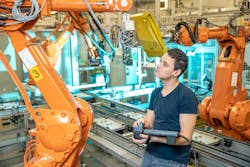The Thoughtful Approach to Automation
If you think automation is just for the big guys, there’s good news. Thanks to recent technology, including advancements in sensors, software, vision systems and more, small manufacturers can benefit from using collaborative robots (cobots) or industrial robots to enhance productivity, reduce workforce injury, yield a more consistent product and benefit from the shift to an automation format that is not totally dependent on an exhausting workforce hiring process.
Making a move to a more automated workplace may seem like a scary endeavor, but it certainly doesn’t have to be, provided you take the time up front to examine workflows and remove lingering inefficiencies. To do this, you’ll need to allow for a more efficient automated operation, weigh the increased cost of equipment against what was previously spent on labor, and not start bigger than you can handle.
Start with an honest assessment
At the root of automation within manufacturing is a lean approach, based on the principles of creating an environment that’s repeatable and efficient. If you’re considering becoming an automated shop, the first step is examining the entire operation with VSM (value stream mapping). The benefit of VSM, if conducted correctly, is to eliminate waste from the manufacturing process to make it lean and efficient.
VSM will help identify how ready you are to move into an automated workplace and what needs must be addressed first, along with examining the entire facility’s layout to eliminate or reduce wasted motion. VSM will also help identify downtime and flush out its greatest cause.
Another benefit to a VSM assessment is a clearer understanding of what the future could look like. Consider how automating inspections could allow your shop to take on additional work since automated inspections can free up workers to engage in production, increasing capacity so that more customer-requested work can be performed.
Focus on low-hanging fruit
Following a VSM assessment, companies that identify an automation solution must now look at an implementation process where risk is low, but benefits are high, i.e., the low-hanging fruit. This is a simple way to get automated with processes that are not high level.
Adding a cobot to work alongside a trained employee offers the best chance for early success and is a popular first step within manufacturing. You can easily program a cobot to perform repetitive tasks that traditionally have been handled by a worker, eliminating the need for someone to spend long hours at a workstation or in front of machinery.
Cobots are extremely efficient in the following areas:
Low-value "D" tasks
- Dull
- Dirty
- Difficult
- Dangerous
Line operations
- Machine tending
- Pick and place
- Palletizing
Because cobots can help eliminate the need for people to execute low-skill tasks within an organization, they also serve to provide added job satisfaction to employees and less turnover. Workers become energized when they are repurposed to higher-value work.
Following are four possibilities for where value can be realized in repurposing workers:
- Autonomous vehicles and loaders: Moving product from the warehouse to the shop floor is an excellent opportunity to help repurpose workers.
- Quality inspections: Workers can assume higher-level tasks by employing a robotics arm, complete with a camera, for inspecting parts.
- Machine monitoring: Workers can monitor data on multiple machines once repurposed, allowing for more efficient data-gathering.
- Machine tending: Technical and difficult-to-automate tasks can now be handled by repurposed workers. A robotic arm, with the correct end-effector, can help load and unload high-volume/low-mix parts in CNC machines.
Selecting the right automation option
Early on, it’s important to have wins that showcase initial success. Automating low-level tasks can have an instant and positive impact within your facility, allowing you to showcase automation benefits to those who may be worried about the return on the investment. Plus, by moving workers into higher-value tasks, you can create an even more positive work environment and build momentum internally, as everyone in your shop becomes aware of the imbalance of operations that create inefficiency.
Lower-level tasks, wasted movement, housekeeping issues, etc., are now relegated to the automation process. As you adopt automation technologies of any kind, keep in mind that implementation is more effective in stages, especially when a company is doing most of the installation and programming itself.
Robert Goosen is associate director, engineering and technology services, at Purdue MEP; Kyle Squillace is a technology acceleration specialist at Purdue MEP; and Craig Zehrung, PhD is lead laboratory operations specialist at Purdue University School of Industrial Engineering. Purdue MEP, a part of the MEP National Network, assists manufacturers in Indiana by identifying areas for improvement, helping to streamline processes, and increasing competitiveness. Purdue MEP serves hundreds of companies annually by implementing continuous improvement principles in the areas of productivity, growth and technology.

